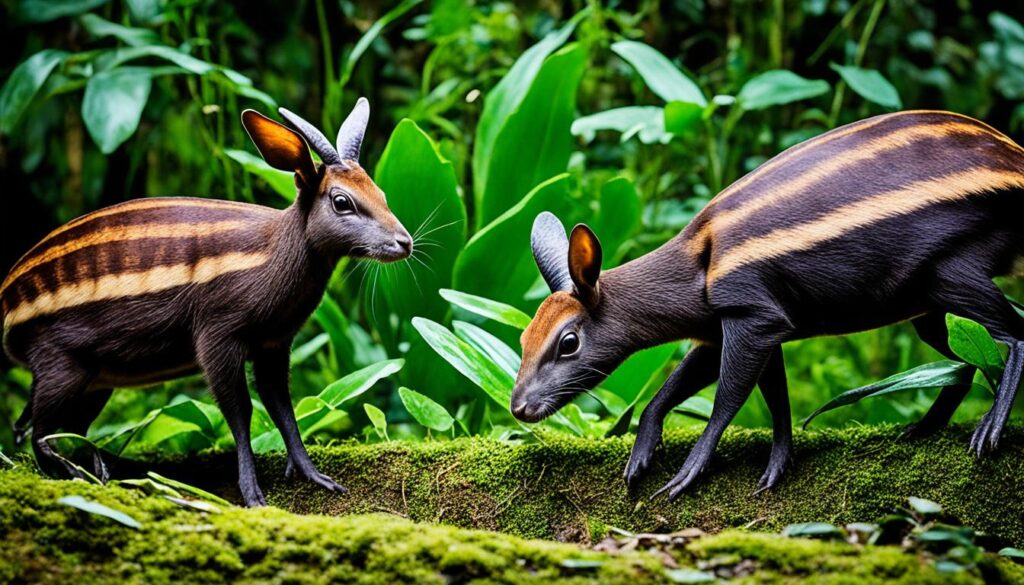Did you know that Laos, a landlocked country in southeastern Asia, is not only rich in cultural heritage, but also home to an astounding array of wildlife? With its diverse range of habitats, Laos is a haven for animal species, from majestic elephants to rare and endangered creatures.

Key Takeaways:
- Laos is home to a variety of animal species, including the endangered saola and Annamite striped rabbit.
- The Mekong River and its wetlands support a diverse community of plants and animals.
- Laos has over 740 recorded bird species, making it a paradise for bird enthusiasts.
- Conservation efforts are underway to protect wildlife in Laos, but challenges such as habitat loss and illegal hunting persist.
- Ecotourism plays a crucial role in wildlife conservation by raising awareness and supporting local communities.
Habitats in Laos
Laos is blessed with a diverse range of habitats that provide essential support to its rich wildlife. From tropical forests to wetlands and mountainous regions, the country offers a variety of ecosystems where unique plant and animal species thrive.
The tropical broadleaf forests of Laos are particularly noteworthy, covering a significant portion of the land area. These lush forests are home to a wide array of wildlife, including charismatic species such as gibbons, majestic tigers, and a diverse range of bird species.
The Annamite Range in Laos stands out as a hotspot for biodiversity, boasting an impressive level of endemism. This mountain range supports a remarkable array of unique flora and fauna, making it a critical habitat for the survival of many endangered species in Laos.
In the southern part of the country, wetlands and swamp forests create vital habitats for a diverse community of plants and animals. These wetlands provide a sanctuary for various species and contribute to the overall richness of Laos’ biodiversity.
The mountainous regions of Laos, including the Luang Prabang Range and the Annamite Range, offer distinct ecosystems shaped by high altitudes and rugged terrain. These mountain ranges create habitats that harbor specialized flora and fauna, adapted to the challenging conditions.
Overall, the varied habitats in Laos provide the foundation for the country’s remarkable wildlife diversity. Protecting and conserving these habitats is crucial for the long-term survival of numerous species and the preservation of Laos’ natural heritage.
Wildlife in Laos
Laos is home to a diverse range of wildlife, including endangered species, mammals, birds, reptiles, amphibians, and fish. The country boasts a significant population of Asian elephants, tigers, gibbons, bears, and various ungulates, contributing to its rich biodiversity. The diverse bird population in Laos includes over 740 recorded species, making it a paradise for birdwatchers and nature enthusiasts.
Reptiles such as snakes and monitor lizards can be found in the forests and wetlands of Laos, while amphibians such as frogs and newts thrive in its freshwater ecosystems. The Mekong River, one of the world’s longest rivers, is home to various species of fish, including the critically endangered Mekong giant catfish, which can reach up to 10 feet in length.

Unfortunately, the wildlife in Laos faces numerous threats. Habitat loss due to deforestation, agricultural expansion, and infrastructure development has led to the fragmentation and degradation of ecosystems. Illegal hunting and the illegal wildlife trade also pose significant dangers to the survival of many species.
| Category | Examples |
|---|---|
| Mammals | Asian elephants, tigers, gibbons, bears |
| Birds | White-winged ducks, Giant ibis, Giant hornbill |
| Reptiles | King cobras, Burmese pythons, Green turtles |
| Amphibians | Mekong River newts, Cascade frogs, Wrinkled frogs |
| Fish | Mekong giant catfish, Pangasius catfish, Siamese mud carp |
To protect these endangered species and preserve Laos’ wildlife heritage, conservation efforts are underway. Conservation organizations, national parks, and wildlife sanctuaries play a crucial role in safeguarding habitats and implementing conservation measures. However, more needs to be done to combat habitat loss, illegal hunting, and the wildlife trade in order to secure a sustainable future for the wildlife in Laos.
Conservation Efforts in Laos
Despite the challenges faced by wildlife in Laos, there are ongoing conservation efforts to protect and preserve the country’s biodiversity. Laos has established several protected areas and wildlife sanctuaries that play a crucial role in safeguarding important habitats and species.
These protected areas in Laos serve as havens for wildlife, providing habitats for a diverse range of animal and plant species. National parks such as Nam Ha and Dong Phou Vieng protect vast tracts of tropical forests, while the Xe Pian and Nakai-Nam Theun National Biodiversity Conservation Areas ensure the preservation of critical ecosystems.
Ecotourism also plays a significant role in wildlife conservation in Laos. Tourists have the opportunity to witness the country’s diverse wildlife while actively supporting conservation efforts. Sustainable tourism initiatives promote responsible wildlife viewing and aim to generate income for local communities, creating a positive cycle of conservation and economic development.
However, Laos still faces the challenge of illegal wildlife trade, which poses a threat to endangered species and undermines conservation efforts. The demand for exotic pets, traditional medicines made from animal parts, and ivory drives the illicit trade. Stronger enforcement of wildlife protection laws and collaboration with international organizations are crucial in combatting this issue and preserving Laos’ unique wildlife.
Despite these challenges, the dedicated efforts of conservation organizations, government agencies, and local communities are making a positive impact on wildlife protection in Laos. By raising awareness, promoting sustainable tourism, and actively working towards wildlife conservation, Laos holds the promise of a brighter future for its diverse ecosystems and the magnificent creatures that call it home.
Challenges for Wildlife in Laos
Wildlife in Laos faces several challenges that threaten their survival. The country’s rich biodiversity is under threat due to habitat loss, illegal hunting, and the wildlife trade.
Habitat Loss
Habitat loss in Laos is primarily caused by deforestation and the expansion of human activities. The country has experienced significant deforestation in recent years, resulting in the destruction of important habitats for wildlife. The clearance of forests for agriculture, logging, and infrastructure development has led to the fragmentation and degradation of ecosystems, jeopardizing the survival of numerous species.
Illegal Hunting
Illegal hunting is another major challenge faced by wildlife in Laos. Animals are targeted for their meat, body parts, and as exotic pets. Endangered species such as tigers and pangolins are particularly vulnerable to poaching activities. The demand for wildlife products, both domestically and internationally, fuels this illegal trade.
Wildlife Trade
The wildlife trade in Laos contributes to the decline of many species. Animals are captured and traded for various purposes, including traditional medicine, luxury items, and the exotic pet market. The unregulated trade not only threatens the survival of wildlife but also poses risks to public health, as it can facilitate the transmission of zoonotic diseases.
To address these challenges and ensure the long-term survival of wildlife in Laos, conservation efforts and stricter enforcement of wildlife protection laws are crucial. It is essential to promote sustainable land use practices, strengthen protected area management, and raise awareness about the importance of wildlife conservation.
| Challenges | Impact |
|---|---|
| Habitat Loss | Loss of important habitats for wildlife, fragmentation of ecosystems |
| Illegal Hunting | Threat to endangered species, disruption of ecological balance |
| Wildlife Trade | Risk to wildlife populations, potential for zoonotic disease transmission |
By addressing these challenges and implementing effective conservation strategies, Laos can protect its unique wildlife and preserve its rich biodiversity for generations to come.

Ecotourism and Wildlife Conservation in Laos
Ecotourism is an essential component of the ongoing wildlife conservation efforts in Laos. Through sustainable tourism practices, visitors can engage in responsible wildlife viewing while supporting local communities and contributing to conservation initiatives throughout the country.
One notable example of community-based conservation in Laos is the Gibbon Experience in Bokeo Province. This unique ecotourism initiative provides tourists with the opportunity to experience the country’s diverse wildlife, including the rare and endangered gibbons, while directly benefiting the local communities.
By participating in the Gibbon Experience and other similar projects, travelers not only generate income for the residents but also raise awareness about the significance of protecting Laos’ wildlife and their habitats. These initiatives play a crucial role in preserving the delicate balance of ecosystems and ensuring the long-term sustainability of Laos’ natural heritage.
Benefits of Ecotourism in Laos
Ecotourism initiatives in Laos offer several advantages for wildlife conservation and local communities:
- Preservation of Biodiversity: By promoting responsible wildlife viewing practices, ecotourism contributes to the preservation of Laos’ rich biodiversity by minimizing disturbances to natural habitats and reducing the negative impact on wildlife populations.
- Economic Empowerment: Community-based ecotourism projects provide an alternative source of income for local communities, reducing dependence on activities that may harm wildlife, such as illegal hunting or the wildlife trade. Tourism revenue can be reinvested in conservation efforts and community development.
- Cultural Exchange: Ecotourism encourages cultural exchange between tourists and local communities, fostering respect and understanding for different ways of life. This exchange helps promote cultural preservation and awareness of the interconnectedness between vibrant cultures and thriving ecosystems.
- Education and Awareness: Ecotourism initiatives create opportunities for education and awareness-building about the importance of wildlife conservation. Tourists gain a better understanding of the challenges faced by wildlife in Laos and become advocates for their protection, spreading the message when they return home.
By supporting sustainable tourism practices and participating in well-regulated wildlife tourism activities, travelers can contribute directly to wildlife conservation efforts in Laos. Through their actions, they play a significant role in securing a brighter future for Laos’ unique ecosystems and preserving its diverse wildlife.
| Ecotourism Initiatives in Laos | Description |
|---|---|
| Gibbon Experience | A popular ecotourism project in Bokeo Province that offers visitors the chance to observe gibbons in their natural habitat while contributing to forest conservation and local development. |
| Elephant Conservation Center | A sanctuary dedicated to the protection and welfare of elephants in Laos. Visitors can learn about these majestic creatures and support conservation efforts through educational programs and responsible elephant interactions. |
| Green Discovery | An eco-adventure tour company in Laos that offers a range of sustainable tourism activities, including hiking, kayaking, and wildlife spotting, while prioritizing environmental and cultural preservation. |
Conclusion
Laos is known for its remarkable wildlife diversity, with a wide range of animal and plant species thriving in its diverse habitats. However, the future of wildlife in Laos faces significant challenges, including habitat loss, illegal hunting, and the wildlife trade.
To protect and conserve the precious biodiversity of Laos, ongoing conservation efforts and sustainable tourism initiatives are essential. By supporting ecotourism, enforcing wildlife protection laws, and raising awareness about the importance of conservation, we can work towards creating a brighter future for the wildlife in Laos.
Preserving wildlife diversity in Laos requires a multi-faceted approach that involves the collaboration of government authorities, local communities, and conservation organizations. Together, we can strive for the sustainable management of habitats, the prevention of illegal activities, and the promotion of responsible tourism practices.
With continued efforts and dedication, we can ensure that future generations will have the privilege of experiencing and appreciating the unique and diverse wildlife of Laos. By safeguarding its biodiversity, we not only protect the natural heritage of the country but also contribute to the overall health and balance of our planet’s ecosystems.
